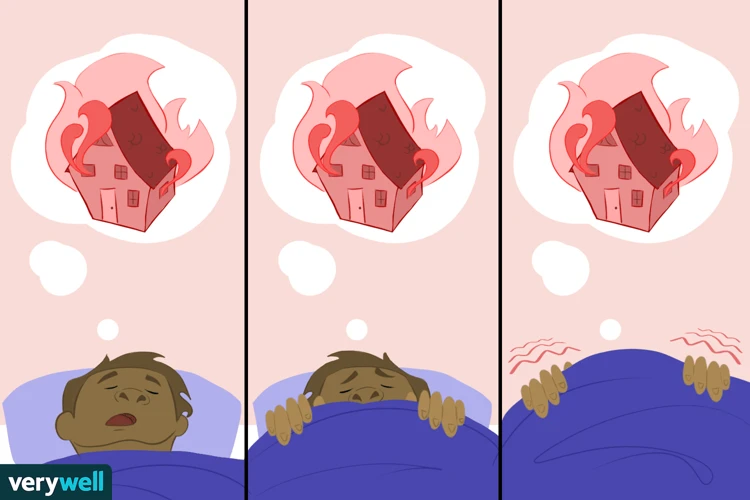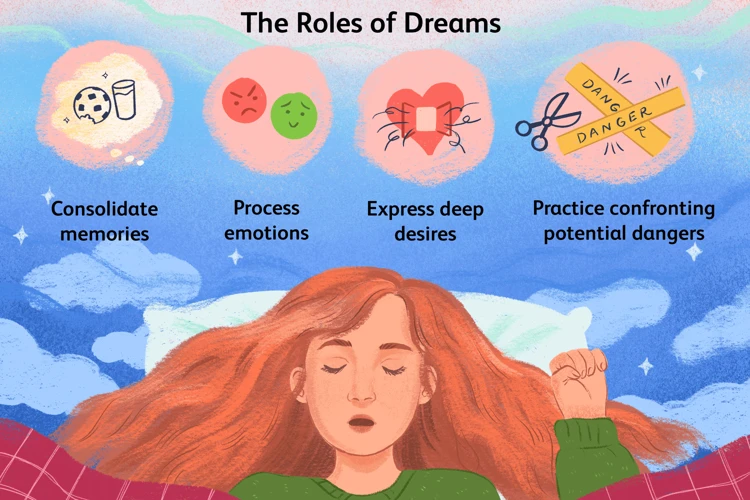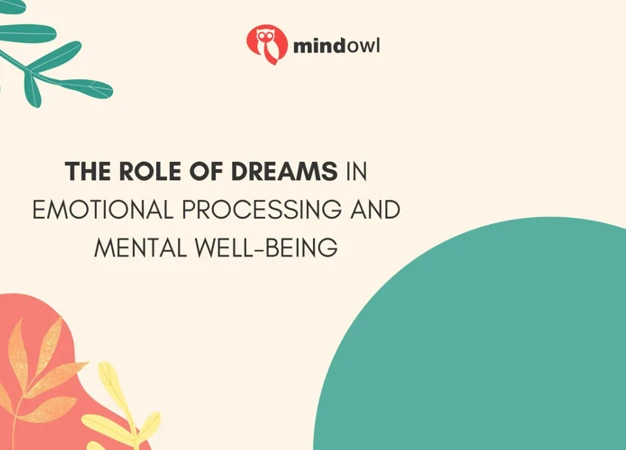Have you ever woken up in the middle of the night, drenched in sweat and filled with a sense of dread from a vivid nightmare? Nightmares have a way of leaving us emotionally shaken, sometimes lingering long after we open our eyes. But what exactly are nightmares, and why do we have them? In this article, we will explore the role of nightmares in processing emotions and memories. We’ll delve into the definition of nightmares, uncover common themes and symbols that often appear, examine how nightmares impact our emotions and memory processing, and explore the psychological perspectives of famous thinkers like Freud and Jung. Additionally, we’ll discuss how nightmares can serve as a form of emotional release and help us process traumatic experiences, as well as how recurring nightmares can highlight repeated emotional patterns. Lastly, we’ll provide techniques for coping with nightmares, such as keeping a dream journal for emotional insight and exploring therapeutic approaches. So, grab a cup of tea, sit back, and prepare to uncover the fascinating world of nightmares and their intricate role in our mental and emotional well-being.
What are Nightmares?

Nightmares are highly vivid and distressing dreams that occur during the rapid eye movement (REM) stage of sleep. They often evoke intense feelings of fear, anxiety, and terror, leaving the dreamer with a lingering sense of unease. While nightmares can vary in content and intensity, they commonly involve themes of danger, being chased, falling, or confronting supernatural creatures. These unsettling dreams may include symbolic representations that reflect the dreamer’s unprocessed emotions, fears, or traumatic experiences. Nightmares can occur in both children and adults, although they are more prevalent in younger individuals due to their active imagination and vulnerability to external stressors. It’s important to note that nightmares are different from night terrors, which are episodes of intense fear and distress during sleep that usually don’t involve vivid dream recall. Understanding the nature of nightmares is essential for recognizing their underlying causes, exploring their impact on emotions and memories, and finding effective coping strategies.
Definition of Nightmares
Nightmares can be defined as vivid and disturbing dreams that cause intense fear, anxiety, or terror upon awakening. These dreams often involve threatening situations or scenarios that evoke a strong emotional response. Nightmares are typically encountered during the REM stage of sleep when brain activity is high, and vivid dreaming occurs. During a nightmare, the dreamer may experience a sense of helplessness or danger, and the events may seem real and immediate. The content of nightmares can vary widely, but common themes include falling, being chased, being attacked, or experiencing a traumatic event. It is essential to differentiate nightmares from other sleep disturbances, such as night terrors or sleep disorders, as they have distinct characteristics and underlying causes. Nightmares can disrupt the sleep cycle and lead to daytime distress and impaired functioning. Understanding the definition of nightmares helps shed light on their impact on emotional well-being and the need for effective coping strategies to address them. For further insights into nightmares, please refer to our article on Understanding Psychological Nightmares.
Common Themes and Symbols in Nightmares
Common themes and symbols in nightmares can provide insight into underlying emotions, conflicts, and fears. While the specific content of nightmares can vary greatly from person to person, there are certain recurring themes and symbols that tend to appear. Some of the common themes include being chased or pursued, falling, experiencing physical harm, being trapped or unable to escape, witnessing or being involved in a disaster or catastrophe, encountering supernatural or monstrous beings, and experiencing feelings of powerlessness or being overwhelmed. These thematic elements in nightmares often symbolize deeper psychological issues or unresolved conflicts in the dreamer’s life. For example, being chased might represent a fear of facing one’s problems or a sense of being pursued by unresolved issues. Falling can symbolize a lack of control or feeling overwhelmed by a situation. It is worth noting that the interpretation of these symbols can vary depending on the individual’s personal experiences and cultural background. By analyzing the themes and symbols in nightmares, individuals can gain a better understanding of their emotions, anxieties, and unconscious thoughts. This self-reflection can be a valuable tool in personal growth and overcoming emotional challenges. For individuals who experience recurring nightmares, paying attention to these common themes and symbols can unveil potential warning signs that should not be ignored. It is crucial to address the underlying issues causing the nightmares and seek appropriate support to improve overall well-being. If you want to learn more about the significance of recurring nightmares, you can check our article on “Unveiling Potential Warning Signs: Recurring Nightmares” for further insights.
Emotions and Memories Connection

The connection between emotions and memories is a complex and intricate process, and nightmares play a significant role in this dynamic interplay. When we experience intense emotions during a nightmare, such as fear, anxiety, or sadness, these emotions can carry over into our waking life, affecting our mood and overall well-being. Nightmares have the power to evoke visceral reactions and elicit strong emotional responses even after waking up, often leaving us unsettled and on edge.
Additionally, nightmares have the ability to impact the processing and consolidation of memories. During sleep, our brains actively work to sort and store information from our waking experiences. Nightmares can act as a catalyst for memory consolidation, enhancing the encoding of emotionally charged events. This means that any memories associated with the intense emotions experienced during a nightmare may become more vivid and salient in our minds.
Nightmares can also serve as a means of processing and integrating emotional experiences from our past. They provide a safe space for us to explore and confront unresolved emotions, traumas, and conflicts. Through the symbolic imagery and narrative of a nightmare, we may gain insights and a deeper understanding of our own emotions and life experiences.
It is worth noting that recurrent nightmares, especially those that involve similar emotional themes or patterns, can be indicative of underlying psychological issues. These nightmares can be a manifestation of unresolved emotional traumas or ongoing stressors in our lives. Recognizing the potential warning signs of recurring nightmares (link to /unveiling-potential-warning-signs-recurring-nightmares/) is crucial in identifying and addressing any deeper emotional or psychological concerns.
In the next section, we will delve into the psychological perspectives on nightmares, exploring the interpretations of renowned thinkers such as Freud and Jung, who have offered unique insights into the significance of these dreams.
Emotions: How Nightmares Impact Our Feelings
Nightmares can have a profound impact on our emotions, often leading to intense feelings that can linger even after waking up. Here are a few ways in which nightmares impact our emotions:
1. Intensified Fear and Anxiety: Nightmares have the ability to evoke intense fear, anxiety, and terror. The vivid and realistic nature of nightmares can make us feel as though we are experiencing the events and emotions in real life. This heightened emotional response can leave us feeling anxious and on edge throughout the day, affecting our overall well-being.
2. Emotional Processing and Release: One possible function of nightmares is to provide an outlet for the processing and release of intense emotions. During sleep, our brain consolidates memories and processes emotions. Nightmares may serve as a way for the brain to process and release any unresolved or repressed emotions, allowing us to confront and work through them on a subconscious level.
3. Impact on Mood and Mental Health: Frequent nightmares can have a negative impact on our mood and mental health. The distress caused by recurring nightmares can lead to feelings of sadness, irritability, and a general sense of unease. In some cases, nightmares may contribute to the development or exacerbation of anxiety disorders or other mental health conditions.
Understanding how nightmares impact our emotions is crucial for developing coping mechanisms and seeking appropriate support. If you find that nightmares significantly disrupt your sleep or affect your daily functioning, it may be beneficial to consult a healthcare professional who can provide guidance and support relevant to your situation.
Memories: How Nightmares Affect Memory Processing
Nightmares play a fascinating role in the processing of our memories. When we experience intense emotions during a nightmare, our brains become highly activated. This heightened state of arousal during sleep can enhance memory consolidation, the process by which our brains convert short-term memories into long-term memories. The emotional intensity of nightmares can essentially “tag” certain memories as significant or important, making them more likely to be retained and recalled later on. This phenomenon is known as the emotional memory enhancement effect. Nightmares can also facilitate the integration of new information with existing memories, leading to a deeper understanding and connection between different aspects of our experiences. However, it’s important to note that extreme or frequent nightmares, especially in the context of sleep disorders, can disrupt the normal functioning of memory processing. Sleep disorders like insomnia or sleep apnea can negatively impact the quality of sleep, leading to fragmented sleep patterns that interfere with the consolidation of memories. If you want to learn more about the complex relationship between sleep disorders and nightmares, you can read our dedicated article on the role of sleep disorders in nightmares. While nightmares can have an impact on memory processing, further research is needed to fully understand the intricate mechanisms behind this relationship.
Psychological Perspective on Nightmares

The psychological perspective on nightmares offers valuable insights into their symbolic meaning and potential underlying psychological factors. Sigmund Freud, the renowned psychoanalyst, believed that nightmares were a manifestation of repressed desires and unresolved conflicts from the unconscious mind. He suggested that nightmares served as a way for the subconscious to bring these hidden desires and conflicts to the surface. According to Freud, analyzing the symbols and themes in nightmares could provide clues to the dreamer’s unresolved psychological issues.
On the other hand, Carl Jung, a prominent psychologist, approached nightmares from a more collective and archetypal perspective. He believed that nightmares contained universal symbols and themes that were shared across cultures and had a deeper meaning. Jung suggested that nightmares could be seen as messages from the collective unconscious, guiding individuals towards self-discovery and personal growth.
Both Freud and Jung emphasized the importance of dream analysis in understanding the significance of nightmares. By exploring the symbols, themes, and emotions present in nightmares, individuals can gain insights into their unconscious thoughts, fears, and desires. This self-reflection can lead to a deeper understanding of oneself and potentially reveal unresolved conflicts or unaddressed psychological issues. By acknowledging and addressing these issues, individuals can work towards resolving them and potentially alleviate the frequency or intensity of nightmares.
Freud’s Interpretation of Nightmares
Freud’s interpretation of nightmares offers valuable insights into the psychological meaning behind these unsettling dreams. According to Freud, nightmares are a manifestation of repressed and unresolved unconscious desires or conflicts. He believed that the content of nightmares represented disguised symbols relating to forbidden or taboo thoughts and emotions. Freud introduced the concept of the “dreamwork,” which refers to the process through which the unconscious mind transforms these forbidden desires into symbolic representations within dreams. Nightmares, in Freud’s view, serve as a way for the unconscious mind to express and process these repressed emotions. By analyzing the symbols and events in nightmares, Freud believed that one could gain access to a deeper understanding of their subconscious desires, fears, and internal conflicts. For example, a nightmare about being chased by a monster could symbolize a person’s fear of confronting their own hidden desires or past traumas. Freud’s interpretation of nightmares provides a framework for exploring the rich symbolism and unconscious elements that underlie these distressing dreams. While his theories have been subject to criticism and debate, they continue to influence the field of dream analysis and offer a fascinating perspective on the role of nightmares in processing emotions and memories.
Carl Jung’s View on Nightmares
Carl Jung, the renowned Swiss psychiatrist and founder of analytical psychology, had a unique perspective on nightmares. He believed that nightmares held great significance in the process of self-discovery and personal growth. According to Jung, nightmares often contained archetypal symbols and imagery that represented universal themes and subconscious aspects of the dreamer’s psyche. He viewed nightmares as a portal to the unconscious mind, where repressed emotions, unresolved conflicts, and unacknowledged aspects of the self resided. Jung emphasized the importance of dream analysis, where the dreamer actively engages with the symbols and themes present in their nightmares to gain insight into their deeper psychological patterns. By exploring and understanding the meaning behind these symbols, individuals could tap into their inner wisdom and facilitate the integration of their unconscious contents. Jung believed that nightmares could serve as a transformative tool, guiding individuals towards self-awareness, healing, and wholeness. To learn more about Jung’s fascinating perspective on dreams and nightmares, click here. [insert internal link to “Understanding Psychological Nightmares” article]
Nightmares as a Form of Emotional Release

Nightmares can be seen as a form of emotional release, providing an avenue for the processing and integration of intense emotions, particularly those associated with traumatic experiences. When we experience a traumatic event, our mind may struggle to process the overwhelming emotions and memories associated with it. This unresolved material can manifest in nightmares, allowing us to confront and work through these emotions in the safe realm of our dreams. Nightmares may act as a cathartic outlet, helping us release and express repressed emotions that we have difficulty acknowledging or expressing in our waking lives. By confronting these emotions in our dreams, we may gradually gain a greater understanding of our fears, anxieties, and traumatic experiences. This process can be deeply healing and may lead to a sense of resolution and closure. In some cases, nightmares can even serve as a warning sign or a prompt to seek professional help, especially when they are overly distressing, recurrent, or interfere with daily functioning. Understanding the potential therapeutic role of nightmares can empower us to view these experiences not just as sources of distress but as opportunities for emotional growth and resilience.
Processing Traumatic Experiences through Nightmares
Nightmares can serve as a mechanism for processing traumatic experiences. When we undergo intense or distressing events, our brains often struggle to make sense of and integrate the emotions and memories associated with these experiences. This can lead to the development of unresolved psychological distress and emotional wounds. However, during REM sleep, the brain’s emotional centers are highly active, making it an ideal time for processing and organizing these emotions and memories. Nightmares can be a way for the subconscious mind to replay and confront the trauma, allowing for a gradual desensitization and emotional release. The vivid and intense nature of nightmares can also serve as a catalyst for bringing repressed or buried memories and emotions to the surface, providing an opportunity for healing and resolution. Through nightmares, individuals can begin to process and make sense of their traumatic experiences, gradually reducing the emotional intensity associated with them. It’s important to note that while nightmares can be a part of the healing process, they should not be seen as a substitute for professional therapy or trauma counseling.
Role of Nightmares in Resolving Conflicts
Nightmares can serve as a powerful tool for resolving conflicts within ourselves. When we experience a nightmare, it often brings to the surface unresolved emotions, fears, or traumas that we may have suppressed or ignored. These troubling dreams can act as a symbolic representation of the conflicts we are facing in our waking lives, allowing us to confront and process them in a safe space. By exploring the themes and symbols presented in nightmares, we can gain insight into our deepest fears and anxieties, bringing them into our conscious awareness. This awareness provides an opportunity to address and resolve these conflicts, leading to personal growth and emotional healing. Nightmares can act as a wake-up call, reminding us to pay attention to our unaddressed emotions and conflicts, and motivating us to take action to resolve them. Through techniques such as dream analysis, therapy, or self-reflection, we can gain a deeper understanding of the underlying issues reflected in our nightmares and work towards finding resolution. By acknowledging and exploring the message behind our nightmares, we can use them as a catalyst for personal transformation and conflict resolution in our lives.
Recurring Nightmares and Repeated Emotional Patterns

Recurring nightmares are a particular type of nightmare that repeats itself with similar themes, settings, or characters. These ongoing nightmares can be relentless and often leave the individual feeling trapped in a cycle of fear and anxiety. One possible explanation for recurring nightmares is the presence of unresolved emotional patterns in the individual’s life. These emotional patterns may stem from past traumas, unresolved conflicts, or unexpressed emotions. The content of recurring nightmares often reflects these emotional patterns, serving as a subconscious attempt to process and release these unresolved feelings. For example, someone who has experienced a traumatic event may have recurring nightmares related to that experience as their mind tries to make sense of the trauma and find resolution. Recognizing and understanding the significance of recurring nightmares can provide valuable insights into one’s emotional state and highlight areas that may require attention and healing. It can be helpful to keep a dream journal to track recurring nightmares and identify any common themes or emotions that arise. By addressing the repeated emotional patterns that appear in recurring nightmares, individuals can begin to work through past trauma, resolve conflicts, and ultimately find relief from their nightly torment. To learn more about potential warning signs and strategies for managing recurring nightmares, you can read our article on unveiling potential warning signs in recurring nightmares.
Understanding the Significance of Recurring Nightmares
Recurring nightmares are a phenomenon that can have significant psychological significance. When a person experiences the same or similar nightmares repeatedly, it suggests that there may be deeper underlying issues that need to be addressed. These nightmares often serve as a subconscious signal, alerting us to unresolved traumas, anxieties, or emotional patterns that we may be struggling with. They can be seen as a manifestation of the mind’s attempt to process and integrate experiences or emotions that have not been fully dealt with. Recurring nightmares can occur in response to a specific event or as a result of ongoing stressors in our lives. In some cases, these nightmares may even be indicative of a sleep disorder, such as post-traumatic stress disorder (PTSD), which requires professional intervention and treatment. It is crucial to pay attention to recurring nightmares and to seek help if they persist, as they can offer valuable insight into underlying emotional issues and serve as a starting point for healing and personal growth. By acknowledging the significance of recurring nightmares, we can begin to unravel their hidden messages and take steps towards resolving the unresolved issues in our lives. If you’re interested in learning more about recurring nightmares and their potential warning signs, you can visit our article on unveiling potential warning signs of recurring nightmares.
Identifying and Addressing Repeated Emotional Patterns
Identifying and addressing repeated emotional patterns in our nightmares can provide valuable insights into our subconscious mind and help us resolve underlying issues. When we experience recurring nightmares with similar themes or emotions, it may indicate that there are unresolved emotions or unresolved conflicts in our waking life. By paying attention to the patterns and themes that frequently appear in our nightmares, we can begin to identify the specific emotions that are being triggered. For example, if nightmares often revolve around feelings of powerlessness or being chased, it may suggest a deep-seated fear or sense of vulnerability. It is essential to reflect upon these emotions and explore their connection to our waking life experiences. Keeping a dream journal can be a helpful tool in recording and analyzing recurring nightmares, allowing us to identify patterns more easily. Once we have identified the repeated emotional patterns, it is crucial to address them through various therapeutic techniques or seeking professional help if needed. These techniques can include cognitive-behavioral therapy (CBT), which helps reframe negative thought patterns, exposure therapy to gradually confront and desensitize fears, or creative outlets such as art therapy to express and explore difficult emotions. Through these interventions, we can work towards healing and resolving the emotional patterns that are manifesting in our nightmares, leading to improved emotional well-being and peaceful sleep.
Techniques for Coping with Nightmares
Coping with nightmares can be challenging, but there are several techniques that can help individuals better manage these unsettling experiences:
1. Keeping a Dream Journal for Emotional Insight: Keeping a dream journal can be a valuable tool for gaining insight into the underlying emotions and themes present in nightmares. By recording details of the dream upon waking, individuals can identify patterns, symbols, and triggers that may be linked to their waking life experiences. This self-reflection can provide a deeper understanding of emotions and aid in the identification of unresolved issues that may contribute to recurring nightmares.
2. Therapeutic Approaches to Manage Nightmares: Seeking therapy or counseling can be beneficial for individuals experiencing frequent and distressing nightmares. Therapists may use techniques such as imagery rehearsal therapy (IRT), which involves rewriting the ending of the nightmare to create a more positive outcome. Cognitive-behavioral therapy (CBT) can also help individuals identify and challenge negative thought patterns associated with nightmares, promoting more positive dream experiences.
3. Creating a Calm Sleep Environment: Establishing a peaceful and relaxing sleep environment can contribute to better sleep quality and reduce the likelihood of nightmares. This can include practices such as creating a consistent bedtime routine, ensuring the bedroom is dark and quiet, and avoiding stimulating activities or substances before sleep, such as caffeine or electronic devices.
4. Stress Reduction Techniques: Stress and anxiety can contribute to the occurrence of nightmares. Engaging in relaxation techniques like deep breathing exercises, meditation, or yoga before bedtime can help reduce overall stress levels and promote a more peaceful sleep.
5. Imagery Distraction: When faced with a nightmare, using imagery distraction techniques can help redirect the focus and interrupt the fear response. This involves mentally picturing a pleasant and calming scene or engaging in positive visualization to shift the attention away from the nightmare content.
It’s important to note that if nightmares persist or significantly impact daily functioning, it is advisable to seek professional help from a healthcare provider or mental health professional. They can provide additional guidance and support in managing and understanding nightmares.
(Link to be used: /understanding-psychological-nightmares/)
Keeping a Dream Journal for Emotional Insight
Keeping a dream journal can be a valuable tool for gaining emotional insight and understanding the messages conveyed in nightmares. By recording dreams immediately upon waking up, individuals can capture the details, emotions, and symbols experienced during the dream state. This practice helps to reinforce dream recall and allows for reflection and analysis later on. Maintaining a dream journal serves several purposes. Firstly, it provides a safe space to express and process emotions that arise from nightmares. Journaling allows individuals to externalize their fears and anxieties, which can provide a sense of relief and release. Secondly, it helps identify patterns and recurring themes in dreams, which can offer valuable insights into one’s emotional state and unresolved issues. By recognizing common symbols or scenarios, individuals can begin to decipher the underlying messages their nightmares are conveying. Additionally, a dream journal can assist in recognizing connections between waking life experiences and dream content, shedding light on potential triggers for nightmares. To keep a dream journal effectively, it is important to record as many sensory details, emotions, and symbols as possible. Using descriptive language and vivid imagery helps to preserve the essence of the dream and facilitates analysis later on. A dream journal can be as simple as a notebook by the bedside or a digital journaling app, whichever format one finds most convenient. Ultimately, a dream journal serves as a powerful tool for emotional exploration and self-discovery, enabling individuals to better understand and navigate the world of their dreams.
Therapeutic Approaches to Manage Nightmares
There are several therapeutic approaches that can be helpful in managing nightmares and reducing their frequency and intensity.
One such approach is cognitive behavioral therapy for nightmares (CBT-N). This therapy aims to identify and challenge negative thought patterns and beliefs that contribute to the occurrence of nightmares. Through CBT-N, individuals can learn techniques such as imagery rehearsal therapy, which involves rewriting the nightmare script to create a more positive outcome. This process helps desensitize the emotional response to the nightmare and promotes better sleep.
Another therapeutic approach is exposure therapy, which involves gradually exposing individuals to the content or themes of their nightmares in a safe and controlled environment. By repeatedly addressing the fears and anxieties associated with the nightmares, individuals can develop a sense of mastery and reduce the emotional impact of these dreams.
Eye movement desensitization and reprocessing (EMDR) therapy is another effective approach for managing nightmares, especially those related to trauma. EMDR combines elements of cognitive therapy with specific eye movements or other forms of bilateral stimulation to help individuals process traumatic memories and reduce the distressing nature of associated nightmares.
In addition to these therapeutic techniques, other strategies such as relaxation exercises, such as deep breathing and progressive muscle relaxation, can help manage stress and facilitate better sleep. Creating a calming bedtime routine, ensuring a comfortable sleep environment, and adopting healthy sleep habits can also contribute to reducing the occurrence of nightmares.
It’s important to remember that finding the right therapeutic approach may require some experimentation, as what works for one individual may not work for another. Consulting with a qualified mental health professional can provide invaluable guidance and help tailor a treatment plan that addresses the specific needs and experiences of the individual dealing with nightmares.
Conclusion
In conclusion, nightmares play a significant role in processing emotions and memories. They serve as a window into our unconscious mind, allowing us to confront and process unresolved emotions, fears, and traumatic experiences. Through nightmares, we can experience a form of emotional release and gain insights into recurring emotional patterns that may be affecting our daily lives. Psychological perspectives, such as those of Freud and Jung, shed light on the deeper meanings and symbolic representations within nightmares. It is important to remember that nightmares are a normal part of the human experience, and they can be managed and coped with in various ways. Keeping a dream journal can provide valuable insights into our emotional well-being, while various therapeutic approaches can help in addressing and managing nightmares. By understanding the significance of nightmares and implementing coping techniques, we can navigate their impact on our emotions and memories, leading to a healthier and more restful state of mind.
Frequently Asked Questions
What triggers nightmares?
Nightmares can be triggered by various factors including stress, anxiety, trauma, medications, sleep disorders, and certain foods or substances.
Can nightmares be a symptom of a sleep disorder?
Yes, recurring nightmares can be a symptom of sleep disorders such as sleep apnea, insomnia, or post-traumatic stress disorder (PTSD).
Are nightmares more common in children?
Yes, nightmares are more common in children as their imagination is more active, and they may be more prone to fears and anxieties.
Do nightmares serve any purpose?
Some theories suggest that nightmares serve as a means for our mind to process and deal with difficult emotions, memories, and traumatic experiences.
Why do nightmares feel so real?
Nightmares feel so real because they occur during the REM stage of sleep when brain activity is similar to wakefulness, intensifying emotions and sensory experiences.
How can I prevent nightmares?
Establishing a regular sleep routine, managing stress, avoiding certain foods and substances before bed, and creating a calming sleep environment can help prevent nightmares.
Should I seek professional help for recurring nightmares?
If recurring nightmares are causing significant distress and affecting your quality of life, seeking professional help from a therapist or sleep specialist can be beneficial.
Can lucid dreaming help control nightmares?
Yes, practicing lucid dreaming techniques can potentially help individuals gain control over their dreams, including nightmares, and transform them into more positive experiences.
What is the link between nightmares and PTSD?
Nightmares are a common symptom of post-traumatic stress disorder (PTSD) and are often a way for the mind to process and confront traumatic experiences.
Are nightmares more frequent during certain stages of life?
Nightmares are more common during childhood and adolescence, but they can occur at any stage of life. They may also be more prevalent during periods of significant stress or transition.








